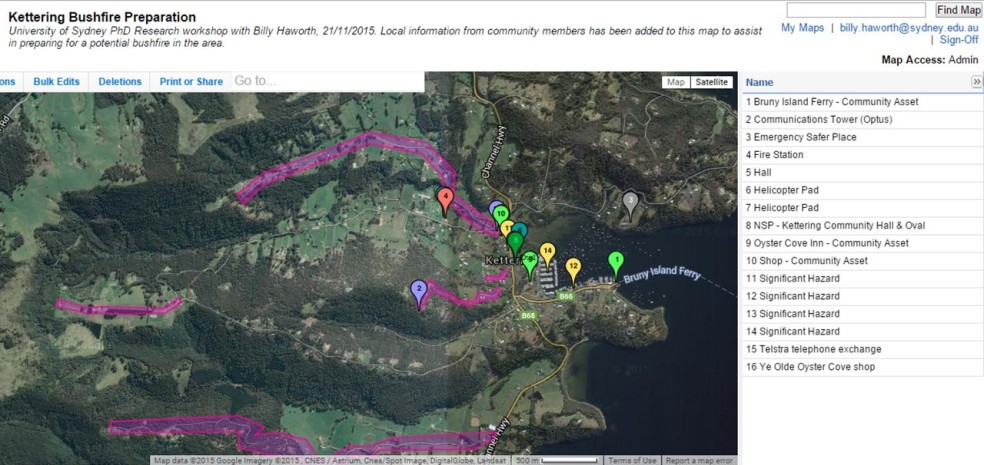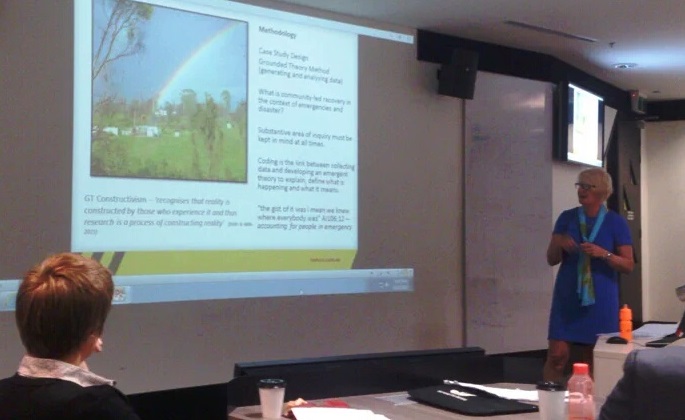Following on from my last post on the community mapping workshop I ran in Kettering, this post describes the next workshops as part of my PhD fieldwork for the topic VGI, community engagement and bushfire preparation. Rather than repeating content from the last post about the research context, and the purpose and description of the workshops, I’ll go straight to discussing how the workshops went and what I observed.

At the workshop held in St Marys on Saturday 10 people from the area participated, recruited predominantly through Bushfire Ready Neighbourhoods (BRN) networks, a mail-out to a random sample of 150 households, flyers in local shops and word-of-mouth. Participants were varied, including an emergency management consultant, local council member, farmers, and retirees, for instance, providing a diverse group with useful local knowledge to contribute to the mapping activities. Assisting me with this workshop was David Cleaver from the BRN program at the Tasmania Fire Service, and volunteer assistant from the University of Sydney, RJ McDonald.
Participants were also from varying locations around St Marys and not from the town itself, which made the paper mapping activity a little difficult for some. Their homes and the areas they were most familiar with were not in the frame of the paper maps at the scale I had printed them. This is probably quite typical of many rural and bushfire prone areas with many living in smaller places, often on properties, and travelling to a nearby larger town or community when they need to. This limitation of the paper mapping proved to highlight a benefit of digital mapping for participants where capability exists to navigate the map to different locations and zoom in and out to map information a different scales.
As with the workshop in Kettering, even though some initially found the software a challenge, people generally preferred the computer mapping activity. The paper mapping again was recognised as valuable for its low-tech simplicity for older people and those without internet or computer access and for the connections people make by coming together to work on the maps in person. But apart from the common concerns with online mapping (issues of power outages and computer access; a little worry about privacy and malicious intent) most of the comments on the potential use of web mapping and VGI for bushfire preparation in their community were positive. Rather than leading the web mapping myself like last time, this time I gave a laptop or tablet to the groups to map their information themselves, and, after some hesitation, most then engaged with the activity much more beneficially and began to see even greater potential for mapping in their community. They discussed how portable and up-to-date a web map can be and how useful it may be for others in the community perhaps less engaged in more traditional bushfire preparation activities like forums, such as younger people. They discussed how online mapping would be useful for vulnerable groups such as travellers, people new to the area, and those who speak languages other than English.
Observing the activities and the things participants chose to map, the content tended to focus on response to a fire event, and people didn’t map a lot about their own preparedness. As you can see on the web map screenshot below people mapped services and assets useful to know in a fire event (they also mapped the same things several times – another consideration with crowdsourcing). While this is certainly useful and clearly did still get people engaged in thinking spatially about their bushfire risk and planning, I also see great potential for even more local, more diverse, and more individually-useful information to be mapped. An example might be the locations of people who have tools available to help others clear vegetation and prepare their homes, or sites of cultural significance, or places important to individual families, or identification of vulnerable people in neighbourhoods who might need extra consideration and assistance in preparing for and responding to a fire. And indeed, some participants excitedly discussed at the end of the workshop how they’d like to carry out similar mapping activities in their local areas with their neighbours to better understand bushfire risk and preparation, which was fantastic to hear! Perhaps the real value of mapping and VGI for bushfire preparation lies in the highly local scenario, to create, map, and share geographic information with those at the neighbourhood scale, rather than the broader aggregated community level where the information may become less relevant to specific individuals. As workshop participants said about the paper mapping versus the computer mapping, there is probably value and merit in both.


On Sunday I set up for a workshop in St Helens with help from Suzette Harrison at the BRN and RJ McDonald. I had been told in advance from those at the local council and those previously trying to undertake community engagement works in St Helens that I may not get a large turnout. However I was still pretty disappointed when not a single person arrived for the workshop. After about an hour waiting we called it a day and packed up. I am running four workshops on this trip, partly to explore how community mapping might work in different types of communities, but also as a safety net in case a workshop doesn’t go too well. So this ‘failure’ is disappointing for me given all the time, money, and effort we put in to the event, but it is not detrimental to the research. I’ve got two successful workshops under my belt already with a great amount of information to work with for my thesis, and I still have one more workshop to come this Saturday (December 5th) in Tolmans Hill, which hopefully will also be a useful event.
But of course I have to stop and question why this particular event failed. When I think about the effort I put in to recruiting participants and advertising the event I can’t see much more I could have done. I contacted people who participated in my research in the past about coming to this event (of which 3 confirmed they would attend). I had flyers up in local businesses and community centres. I contacted many groups in the area initially with a general flyer in the mail and later with a personalised email, including the Lions Club, Rotary, day care centres, community development association, schools, arts groups, and local council, to name a few, with a number of these informing me they would share among their networks. I sent information out to a random sample of 150 households in the area. I had the information shared on various local Facebook pages as well as statewide pages like Tasmania Fire Service and Landcare. I also paid for some advertising on Facebook targetted at the St Helens postcode in the week leading up to the event (apparently my $34 spent got my ad to 400 people’s pages). The workshop was also advertised in council newsletters and on the BRN website. Other ideas I had included spots on local radio, in newspapers, or just random door-knocking. But I’m not sure how much difference that would have made.
I was told this community is particularly hard to reach and my experience is similar to others working in this area. In terms of the research, maybe the interest was low because they’ve done a lot of surveys recently? In terms of bushfire preparedness engagement, maybe they generally feel they are prepared enough? Or (worryingly) perhaps they are complacent about the likelihood of a bushfire event impacting them here? St Helens actually experienced a small bushfire event last year where a number of issues arose that I thought might have made this workshop an interesting one. But even a recent event hasn’t triggered widespread interest in fire management in the area (that I or others have seen). Perhaps the idea of giving up four hours on a weekend was just too unattractive (though, I do provide a free lunch!), or perhaps this community was a little too close in proximity to St Marys (about 35 km away; I actually think they are very different communities in a number of key ways so still think there was justification for choosing both). Even still, while I don’t think word of my workshop reached every one of the few thousand residents, I am pretty certain it reached at least several hundred, and it is a bit baffling that not a single person was interested enough to attend. If that is a reflection of their engagement in bushfire preparation broadly, I must say I’m a bit worried about the potential impacts of a bushfire in St Helens, and hopefully further community engagement activities in the future have more success.

Going forward I need to think a bit more about why St Helens didn’t work and relate that to my last workshop in Tolmans Hill. Is there anything I can do differently this week to ensure a good turnout at my last workshop? As I said earlier, I’ve had a good experience overall on the fieldwork so far, and I’m confident that will continue at the next event. Tolmans Hill is a unique place in that it is so close to a large urban centre (Hobart) yet all the houses are surrounded by bush, and Tolmans Hill itself is an entirely residential suburb (no shops, school etc in the immediate area), so I’m looking forward to seeing how folk there respond to the activities and the potential use of VGI and mapping for bushfire preparation in that area.
This fieldwork is funded by the IAWF PhD scholarship and the research is supported by the BNHCRC, Tasmania Fire Service, and the University of Sydney.






